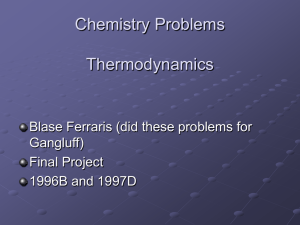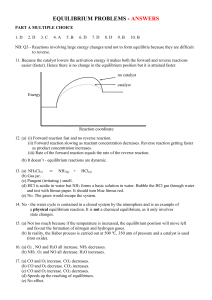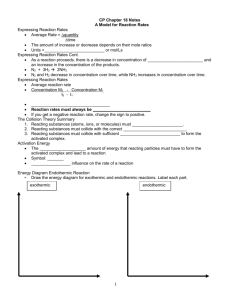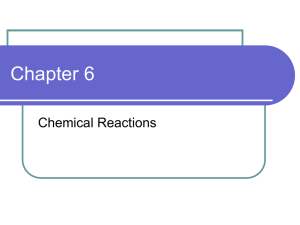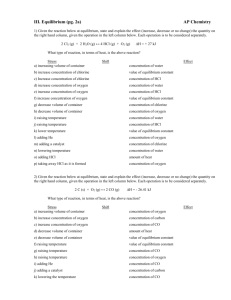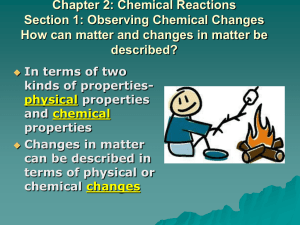Solids and liquids wksts 5-6
advertisement
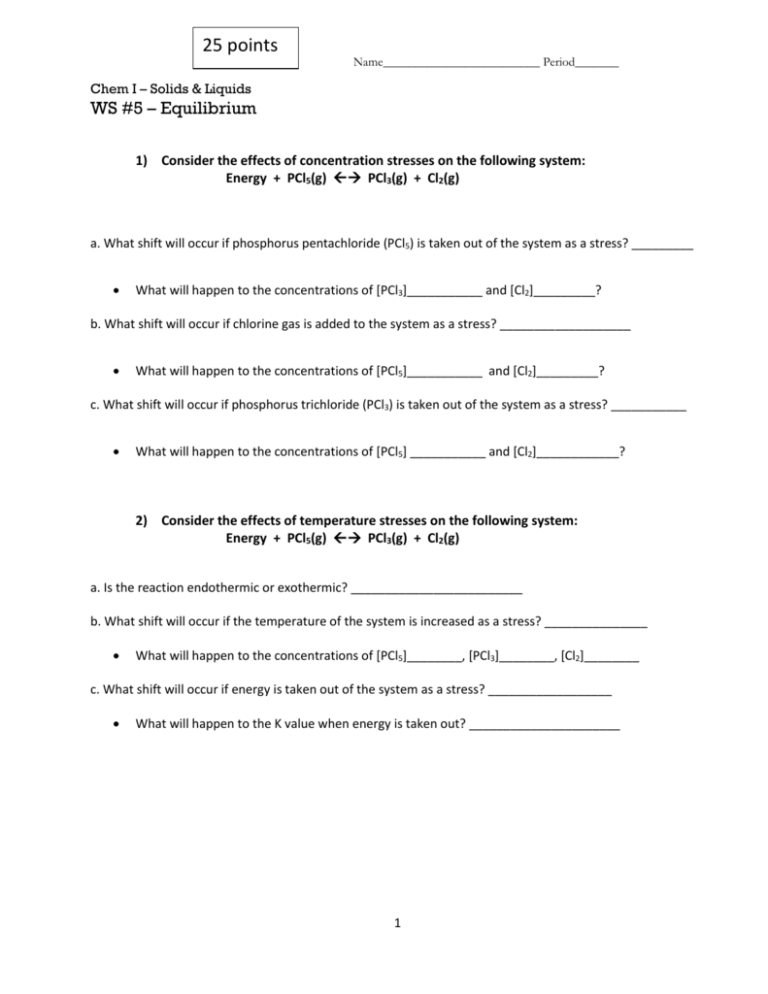
25 points Name_________________________ Period_______ Chem I – Solids & Liquids WS #5 – Equilibrium 1) Consider the effects of concentration stresses on the following system: Energy + PCl5(g) PCl3(g) + Cl2(g) a. What shift will occur if phosphorus pentachloride (PCl5) is taken out of the system as a stress? _________ What will happen to the concentrations of [PCl3]___________ and [Cl2]_________? b. What shift will occur if chlorine gas is added to the system as a stress? ___________________ What will happen to the concentrations of [PCl5]___________ and [Cl2]_________? c. What shift will occur if phosphorus trichloride (PCl3) is taken out of the system as a stress? ___________ What will happen to the concentrations of [PCl5] ___________ and [Cl2]____________? 2) Consider the effects of temperature stresses on the following system: Energy + PCl5(g) PCl3(g) + Cl2(g) a. Is the reaction endothermic or exothermic? _________________________ b. What shift will occur if the temperature of the system is increased as a stress? _______________ What will happen to the concentrations of [PCl5]________, [PCl3]________, [Cl2]________ c. What shift will occur if energy is taken out of the system as a stress? __________________ What will happen to the K value when energy is taken out? ______________________ 1 3) Consider the effects of pressure stresses on the following system: Energy + PCl5(g) PCl3(g) + Cl2(g) a. What shift will occur if pressure is increased as a stress? ________________ What will happen to the concentrations of [PCl5]_________, [PCl3]________, [Cl2]_______ What will happen to temperature? _________________________ b. What shift will occur if the pressure is decreased as a stress? _______________________ What will happen to temperature? ____________________ What will happen to the K value? ___________________ * Predict the effect of the following changes on the position of the equilibrium for each of the following problems. State which way the equilibrium will shift (left, right, or no shift) when each of the following changes is made. Describe what happens to the concentration of the reactant and products and the temperature in order to get back to a new equilibrium. 4) 153kJ + N2O3(g) NO(g) + NO2(g) a. Adding more dinitrogen trioxide (N2O3) b. Adding more nitrogen dioxide (NO2) c. Decreasing pressure of the reaction flask d. Lowering the temperature e. Removing some of the nitrogen monoxide (NO) f. What happens to the K value when temperature is added? 2 5) 2NO(g) + Br2(g) 2NOBr(g) + Energy a. Adding more Br2 b. Removing some NOBr c. Decreasing temperature d. Increasing pressure e. Removing some NO f. What happens to the K value when temperature is decreased? 6) CH4(g) + 4Cl2(g) CCl4(l) + 4HCl(g) + 320 kJ a. Adding more carbon tetrachloride (CCl4) b. Removing some chlorine gas (Cl2) c. Increasing pressure d. Increasing the temperature e. Adding more methane (CH4) f. Adding more hydrochloric acid (HCl) g. What happens to the K value when temperature is removed? 3 Chem I – Solids & Liquids #6 – Equilibrium Shifts * Predict the effect of the following changes on the position of the equilibrium for each of the following problems. State which way the equilibrium will shift (left, right, or no shift) when each of the following changes is made. Describe what happens to the concentration of the reactant and products and the temperature in order to get back to a new equilibrium. 1. NaHCO3(s) + H+(aq) CO2(g) + Na+(aq) + H2O(g) + energy a. what shift will occur if the concentration of sodium bicarbonate (NaHCO3) is increased and what will happen to the concentrations of all reactants and all products and the temperature? b. what shift will occur if water is taken out of the system and what will happen to the concentration of all reactants and products and temperature? c. Hydrochloric acid (HCl) is very soluble. If HCl is added to the system and dissociates into H+, what shift will occur, what happens to concentration of reactants and products and temperature? d. what will happen to the K value if [Na+] is taken out of the system? e. what shift will occur if more carbon dioxide (CO2) is added to the system and how will this affect the K value? 2. C2H6(g) + Cl2(g) C2H5Cl(s) + HCl(g) + energy a. what shift will occur if more chlorine gas (Cl2) is added to the system and what will happen to the concentration of the reactants and products and temperature? b. what shift will occur if C2H5Cl is taken away from the system and what will happen to the concentration of the reactants and products and temperature? c. what shift will occur if the temperature of the system is reduced and what will happen to the concentration of the reactants and products as well as the K value? d. if the pressure on the system is decreased, what shift will occur and what will happen to the concentration of the reactants and products and temperature? 4 3. C2H5OH(l) + 3O2(g) 2CO2(g) + 3H2O(l) + 1418 kJ/mol a. is this reaction endothermic or exothermic and how do you know? b. what shift will occur if the temperature of the system is increased and what will happen to the concentration of the reactants and products as well as the K value? c. if the pressure of the system is decreased, what shift will occur and what will happen to the concentration of the reactants and products and temperature? d. what shift will occur if more water is added to the system and what will happen to the concentration of reactants and products and temperature? 4. 5550kJ/mol + 3CO2(g) + 4H2O(l) C3H8(g) + 5O2(g) a. is this reaction endothermic or exothermic and how do you know? b. what shift will occur if the temperature of the system is reduced and what will happen to the concentration of reactants and products as well as the K value? c. what shift will occur if the pressure of the system is increased and what will happen to the concentration of reactants and products and temperature? d. what shift will occur if carbon dioxide (CO2) is taken out of the system and what will happen to the concentration of reactants and products and temperature? 5
